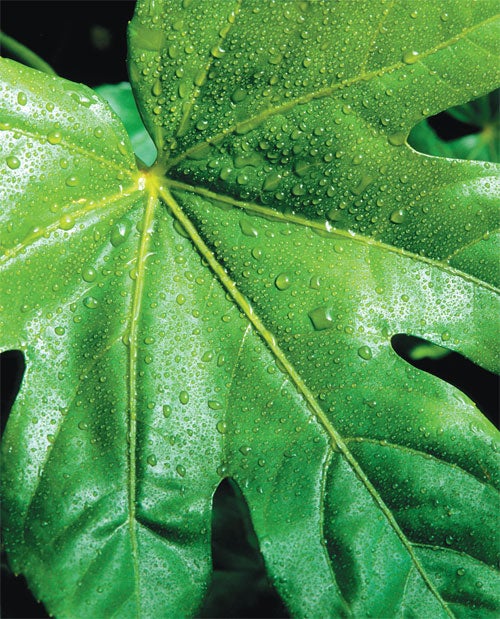Urban gardener, Cleve West: Turning Japanese

I worry sometimes for Fatsia japonica ('Japanese aralia'). It's always been one of my favourite shrubs for an urban garden but occasionally I think it gets treated badly and is made to do things that no self-respecting architectural plant should have to put up with.
A semi-mature or fully grown fatsia works wonders in a garden, with its imposing evergreen, palmate leaves (20cm-50cm wide) wafting exotica from every pore. Small, newly propagated plants, however, tend to look slightly ungainly, out of proportion and occasionally (for example, stuck in a window box), absurd. On new-build developments (where finding an example of sensitive planting is like looking for Lord Lucan) things are no better - they are occasionally found huddling inappropriately with lavender, rosemary or any other Mediterranean fast-growing shrub. Maybe I'm missing some cultural link here, but fatsias deserve better.
Native to Japan and Taiwan, "fatsia" is derived from "fatsi", an old Japanese word for "eight" (referring to the eight lobes on the leaf) and is also known as the Fig-Leafed Palm or False Castor Oil Palm (the real castor oil plant being Ricinus communis). It has become a true urban garden stalwart and, used with sensitivity, will shine in shade and bring more than a glimmer of hope in gloom. It likes a stage to itself when it flowers (round about now), filling a gap between blackened late-summer blooms and winter-flowering shrubs and therefore a useful food source for insects dithering over whether to bed down for the dormant season. The ivy-like, terminal umbels (and leaves for that matter) are the clue that it belongs to the Araliaceae family. In fact, fatsia could be described as an ivy on steroids. The flowers last for several weeks before developing handsome clusters of black berries.
Its ubiquity is only a problem where it is used badly: crudely lumped together with a number of other architectural plants, there is a danger that the strong leaf shapes might cancel each other out. Setting it next to fine-leaved bamboo or small-leaved shrubs will enhance its presence and create quite a dramatic statement in snowfall where the dynamics of the leaves are fully exploited. As it grows to a mature height of 3m, it's worth giving some thought to a permanent location as it dislikes being upended once the roots have made some headway. Having said that, they do respond well to pruning, another reason why they are favoured among city folk. Given the choice I always prefer to see a fatsia in free-range mode, exploring and adapting to its given light conditions, occasionally elevating itself to small tree status (lower leaves trimmed to reveal the slender stems, with room beneath for low growing grasses or Liriope muscari).
Many are grown under glass or imported from warmer climates, so beware planting juveniles during winter without protection from cold, drying winds. In containers, provided they're given the care they need, they become even more useful in small gardens where they can be moved about and, when they reach a decent size, planted out in open ground where they will look more impressive. Large specimen fatsias are not cheap but can really liven up a space. They also seem to respond quicker to their immediate surroundings and will soon take on their own form.
If you want minimal, then a planting scheme using just fatsia, ivy and maybe a type of carex - plus a sprinkling of seasonal bulbs too, just to remind you what time of year it is - would be very effective. If you like the idea of salvaging fatsia's reputation in the urban jungle, but only have room for climbing plants, then Fatshedera lizei, a fatsia-hedera cross, might seem like the perfect solution. But beware. The result is a 1.2m lanky shrub or a woody vine reaching around 3-4m. While the plant definitely has a curiosity value, it unfortunately behaves like a hormonal teenager: limp, devoid of direction and unable to support itself without assistance.
Join our commenting forum
Join thought-provoking conversations, follow other Independent readers and see their replies
Comments
Bookmark popover
Removed from bookmarks